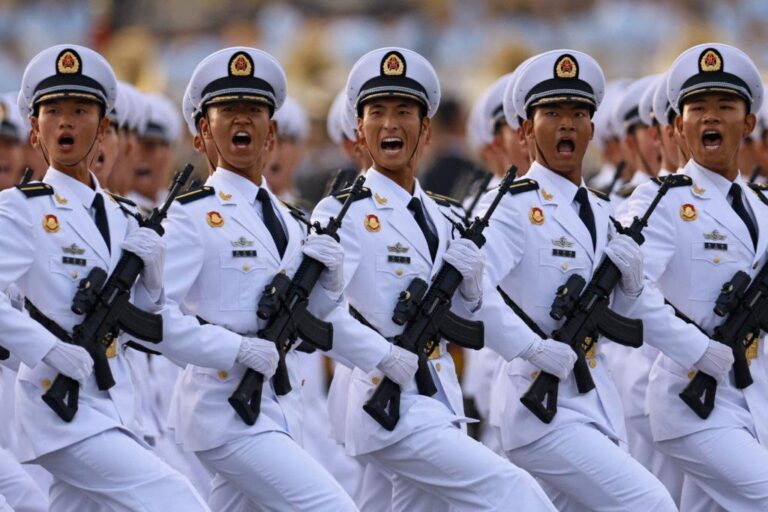Leaders from China, Russia, North Korea, and Iran convened in Beijing on Saturday for a massive military parade, underscoring their united front in a direct challenge to Western powers. The event, marked by an impressive display of military hardware and coordinated messaging, highlighted the growing geopolitical tensions as these nations showcase their strategic alliances and military capabilities on the global stage. This unprecedented gathering in China’s capital signals a significant moment in international relations, reflecting shifting power dynamics and heightened confrontation with the West.
Leaders Unite in Beijing Military Parade Signaling Strategic Alliance Against Western Influence
In a formidable display of military prowess and political solidarity, top leaders from China, Russia, North Korea, and Iran convened in Beijing to participate in an unprecedented military parade. This event not only projected their combined military capabilities but also served as a clear message of defiance against what they described as Western hegemony. The parade featured an array of advanced weaponry, including ballistic missiles, drone technology, and new-generation armored vehicles, illustrating a shared commitment to enhancing their strategic power. Observers noted that the synchronized nature of the event underscored a deepening alliance aimed at counterbalancing Western influence in global affairs.
Analysts highlight several key objectives behind this show of unity:
- Strengthening military cooperation: Joint exercises and technology sharing commitments were announced to further integrate the armed forces of the four nations.
- Political signaling: The parade signifies a unified front that challenges the current international order dominated by Western powers.
- Economic collaboration: Discussions hinted at expanding sanctions evasion tactics and mutual support in sectors like energy and defense.
The following table summarizes the core displays and strategic messages conveyed during the parade:
| Country | Key Military Assets Displayed | Strategic Message |
|---|---|---|
| China | Hypersonic missiles, stealth fighters | Technological dominance and regional authority |
| Russia | Armored tanks, nuclear-capable missiles | Global power projection and deterrence |
| North Korea | Ballistic missiles, cyber warfare units | Asserting sovereignty and tactical resilience |
| Iran | Drone swarms, precision-guided missiles | Asymmetric warfare capability and regional influence |
Showcasing Military Might Experts Analyze Implications for Global Security and Regional Stability
The grand military parade held in Beijing serves as a vivid demonstration of military prowess and a stark message to Western powers. Experts emphasize that this joint display by China, Russia, North Korea, and Iran not only symbolizes strategic alignment but also marks a significant shift in global power dynamics. The parade featured cutting-edge technological advancements, including hypersonic missiles and drone formations, showcasing an unprecedented level of military modernization within these allied nations. Analysts warn that such militarization could exacerbate tensions, triggering an arms race that undermines decades of fragile diplomacy.
Regional security analysts point to several critical implications arising from this display:
- Heightened regional tensions: Neighboring countries may feel compelled to increase their own defense spending, potentially destabilizing already volatile areas.
- Strategic deterrence: The alliance strengthens their collective bargaining power, complicating efforts for conflict resolution in hotspots like the Korean Peninsula and the Middle East.
- Global power recalibration: The parade signals an assertive stance challenging Western hegemony, with possible realignments in diplomatic and military alliances worldwide.
| Country | Key Military Assets Displayed | Regional Impact |
|---|---|---|
| China | DF-17 Hypersonic Missile | Increased Indo-Pacific tensions |
| Russia | T-14 Armata Tanks | Heightened Eastern European security concerns |
| North Korea | Intercontinental Ballistic Missiles | Korean Peninsula instability |
| Iran | Ballistic and Cruise Missiles | Middle East strategic recalibrations |
Recommendations for Western Policymakers Navigating Heightened Geopolitical Tensions
Western policymakers must adopt a multifaceted approach to effectively respond to the emerging alliance showcased in Beijing. Prioritizing diplomatic engagement alongside firm deterrence measures will be crucial to avoid unintended escalation. It is essential to enhance communication channels with both allies and adversaries to reduce risks of miscalculation while reinforcing strategic partnerships across the Indo-Pacific and Europe. Renewed investment in cyber defense, intelligence sharing, and joint military readiness exercises will serve as vital components to maintain a credible security posture.
Key steps for Western governments include:
- Expanding multilateral frameworks that promote transparency and conflict de-escalation
- Leveraging economic tools to counterbalance coercive tactics, such as targeted sanctions and export controls
- Prioritizing resilience in critical infrastructure and supply chains to withstand geopolitical disruptions
- Enhancing public communication strategies to build domestic consensus on foreign policy choices
| Policy Area | Recommended Action | Expected Outcome |
|---|---|---|
| Diplomacy | Initiate backchannel talks and confidence-building measures | Reduce tensions; open dialogue pathways |
| Security | Boost NATO and regional defense collaborations | Strengthen collective defense; deter aggression |
| Economics | Implement smart sanctions and trade adjustments | Limit adversaries’ economic leverage |
Concluding Remarks
As leaders from China, Russia, North Korea, and Iran convened in Beijing for a significant military parade, the event underscored a growing challenge to Western influence on the global stage. The display of military strength and solidarity among these nations signals a shift in geopolitical dynamics, highlighting emerging alliances that could shape international relations in the years ahead. Observers will be closely monitoring how this gathering impacts global power balances and the responses it provokes from Western governments.




